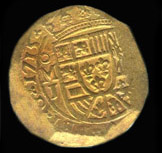 |
|
|
|
|
||
|
Silver bars from
|
19 A Silver Ingot from the wreck of the Dutch East Indiaman Slot ter Hooge lost on November 19th, 1724 off Porto Santo Island
The story of the loss and rediscovery of the Slot ter Hooge is wonderfully retold by the salvor, Robert Stenuit, in his 1975 National Geographic article "The Treasure of Porto Santo." The Slot ter Hooge, outbound to the Orient from Holland, was wrecked on the north shore of Porto Santo in the Madeiras by an Atlantic gale. 221 of the 256 crew and passengers were lost. The ship settled in 60 feet of water and was extensively salvaged a remarkable diver hired by the Dutch. Sand and iron cannon covered at least one box of ingots and coins and prevented a complete salvage. In 1974 Robert Stenuit found a treasure map of the wreck engraved on a tankard and was able to re-explore the wreck successfully. A photo below from the National Geographic article shows Stenuit diving the wreck.
This is Stenuit bar no. DSA10/AI with Robert's original label, hand-signed certificate, and six Stenuit color polaroids of the bar. Also a signed color copy of the 1975 National Geographic pictured to the left, featuring his "Treasure of Porto Santo" article.
One of the most remarkable parts of this story concerns the salvage efforts of the diver, John Lethbridge, whom the Dutch hired to work the Slot ter Hooge. Lethbridge invented diving gear to work the wreck! The National Geographic drawing below copies a contemporary image of Lethbridge's equipment in 1725.
This Slot ter Hooge ingot weighs in at the standard 5.25 lbs (1955 gms) with a fineness of 98.5%. The Zeeland chapter of the VOC adjusted the weight of its bars with diagonal end cuts such as you see on this bar. Very clearly stamped in the center of the bar (often these markings are mushy or corroded) is the company name VOC for Vereenighte Oostindische Compagnie. Above the VOC logo is a (reversed) Z for the Zeeland chapter of the VOC. Below the logo is an M for Middelburg, the Dutch town where the Zeeland chapter was headquartered. A half inch below the M is a many-pedaled rose, the mark of the silversmith in charge of producing these bars at Middelburg. His name is not known. His colleague and contemporary at Amsterdam, you may recall, identifying himself with the mark of jumping goat.
For the China trade the primary precious metal was silver, not gold, and the Chinese preferred their silver in two forms, either small ingots of high purity or Mexican eight reales. Eight reales from other Colonial mints such as Potosi were suspect (after the scandals of the 1650's) and not wanted. A standard 5.25 lb VOC bar had about the same silver content as 79 Mexican 8 reales.C
SOLD
terravitan@aol.com or 480-595-1293
|
|






